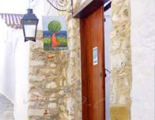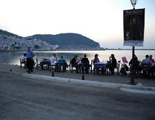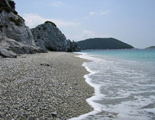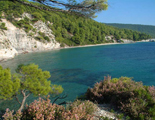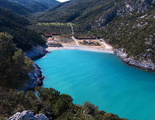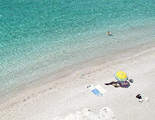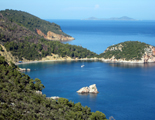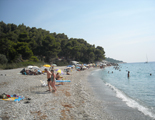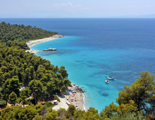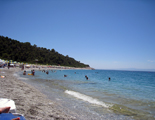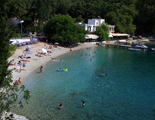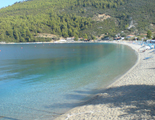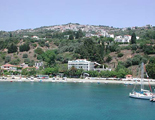 Skopelos Travel Guide
Skopelos Travel Guide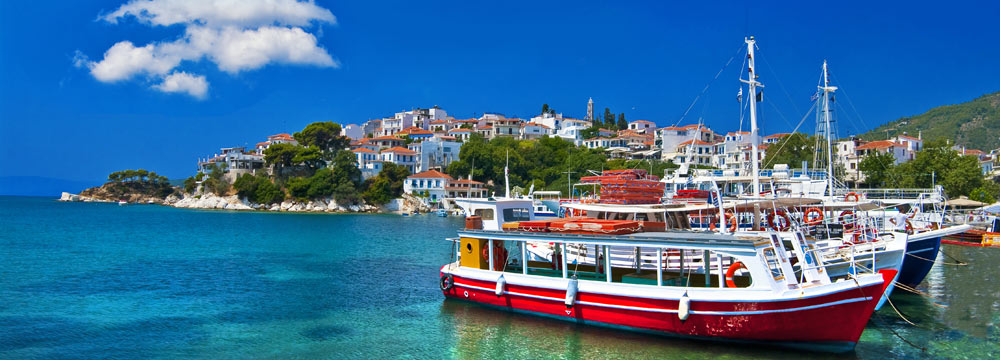
History
Name
Skopelos owes its name to the large number of reefs along its coasts (“Skopelos” is the Greek word for reef). The name Skopelos was first mentioned in the 2nd century A.D. and has since then replaced the island’s previous name, which was “Peparithos”. Peparithos was one of the two sons of Dionysus and Ariadne and the grandson of Minoas, the ancient king of Crete. Although Peparithos’ brother, Stafylos, arrived first at the island, it was named after Peparithos. However, some say that it was Peparithos who arrived first on the island.
Prehistoric times
There are signs of inhabitance of Skopelos in the Neolithic Period, in the 3rd millennium B.C. and more specifically between 2.800 and 2.000 B.C. when inhabitants from Asia Minor arrived to the Island. Around 1.800 B.C. Prince Stafylos arrived at the homonymous bay and the whole island was colonized by Cretans. At Stafylos archaeologists discovered the royal grave including pots, jewels and a sword with a golden handhold, exhibited today at the Archaeological Museum of Athens.
Ancient Times
During the 8th century B.C. Skopelos was under the control or the city-state Halkida. Later, it was conquered by the Athenians, the Macedonians (338 - 146 b.C.) and the Romans in 27 B.C. The major cities in the Ancient Times were Stafylos, Panormos, Knossos which is called Glossa today, and Selinounda, which is called Loutraki. Throughout the Ancient Times, Skopelos was called Peparithos and was renowned for its wine. The ancient writer Sophocles mentions a wine merchant who lost his way in Peparithos in his play “Philoctitis”.
Roman & Byzantine Times
During the Roman (27 B.C.-330 A.D.) and Byzantine Times (330 B.C. - 204 A.D.), Skopelos was declining. Specifically during the Byzantine Times, Skopelos was an island of exile. In the 4th century A.D., the island’s bishop Riginos was decapitated after being tortured in order to deny his faith in Jesus Christ, which of course he never did. Some time later he was recognized as a Saint by the Greek Orthodox Church. Until today, the inhabitants of Skopelos honor Saint Riginos by naming their children after him.
Venetian Times
From 1204 to 1453, Skopelos belonged to the Ghisi family, a family of aristocrats from Venice. In 1453, the inhabitants of Skopelos decided to “offer” the island to the Venetians, in order to avoid the dominance of the Ottomans. Venetians were the island’s owners until 1538 A.D., when the victory of the notorious Algerian pirate Barbarossa led to the beginning of the Ottomans’ occupation.
The Ottoman Period
The Ottoman occupation was rather mild, despite the fact that when the Ottomans arrived at Skopelos in 1538 under the leadership of Barbarossa, they killed many inhabitants and destroyed a part of the island. Skopelos was self-governed and had two main obligations: to pay taxes to the Ottoman Empire and to send 30 sailors each year to serve the Ottoman navy. What is impressive is that not even one person of Ottoman origin ever lived in Skopelos during this period.
Joining Greece
Around 1750 B.C., many “kleftes” and “armatoloi” (supporters of the idea of freedom for Greece, the resistance party of the period) from Epirus and Thessalia came to Skopelos. Skopelos’ inhabitants participated in the Greek revolution of 1821 by helping out whenever it was necessary and by mainly providing ships built ιn the island’s shipyards. In 1830, Skopelos became part of the First Hellenic Republic under the London Protocol.
Recent history
During the 2nd World War, Skopelos was occupied by the Italians (June 1941-September 1943) and then by the Germans (September 1943-October 1944). With the end of the War in 1944, Skopelos was free, along with the rest of Greece. During the Greek Civil War, many inhabitants left the island and migrated to the mainland and abroad. Around 1980, Skopelos was considered as one of the most attractive destinations in Greece, which led to the development of tourism and the return of many old inhabitants to the island.
Skopelos has a rich artistic culture and ceramic pottery, woodcarving and weaving are included among the inhabitants’ activities. In addition, Skopelos boasts one of the largest wooden shipbuilding industries in modern Greece, which started to decline with the introduction of steamships. Today, the art of wooden shipbuilding has disappeared but local craftsmen still repair old wooden vessels.
Skopelos is a top destination in Greece, especially after the filming of the “Mamma Mia” movie. The island attracts many travelers, both from Greece and abroad, due to its undeniable beauties and the fact that it is the greenest island of the country.
Mythology
The myth of Andrina
According to the myth, Andrina was a woman pirate who arrived with a ship full of men pirates at Skopelos in order to conquer it. The men got off at Panormos, while Andrina hid the boat in one of the two bays. When the pirates lost the battle, Andrina fell into the sea and drowned. This is how the two bays, Andrines, got their name.
Drakondoschima
During the Roman and early Byzantine Times, Skopelos was used as an exile location, due to the dragon that lived on the island and was fed by people. One day, Riginos decided to fight against the dragon having as his only weapons a cross made of olive branches and a sword. Riginos managed to tear the earth in two parts with his sword and the dragon fell in the large hole he created. And this specific location is ever since called Drakondoschima, which means shape of a dragon in Greek.
Hotels
Sightseeing
Churches and Monasteries:
Skopelos has 360 churches in total, which is very impressive taking into account the size of the island. At Hora alone, there are 123 churches! Visitors will find churches everywhere when walking around the city of Skopelos; however, Saint Athanasios near the castle, Saint Nicholas and Saint Apostles at Vrahos, Saint Demetrios and Saint George “tis Kyratsos” at Christos, the temple of Virgin Mary at Pyrgos, Panagia Faneromeni, which was initially used as a monastery, and Saint Michael “Synadon” close to the beach are definitely worth a visit. Among the most impressive churches is the temple of Evangelismos, built on a rocky cliff above the sea.
Outside Skopelos Town (Hora), travelers should visit the following monasteries:
The Monastery of Episkopi, about 2 km. to the west of Hora, which was partly built in the Venetian Period, and more specifically in 1078. The monastery is surrounded by walls made of stone, which have to a large extend the shape of castle walls and have carved shapes of animals.
The Monastery of Evangelistria Daponte, founded by monks from Athos (Agio Oros), which has a wonderful view and houses Orthodox images and a golden plated piece of furniture made in Constantinople for placing the Images.
The Monastery of Saint Riginos, who is the protector of Skopelos, about 4 km. to the southwest. This is a Byzantine building surrounded by a large yard which houses the grave of Saint Riginos who died in 362 a.C. The main church was built in 1728, but it replaced an older church of the 5th century. Behind the church, there are the ruins of a temple of Dorian style.
The Monastery of Saint Ioannis Prodromos, at Kastri, close to Glossa. This monastery was built in the 18th century and lies on the top of a rocky cliff at 100 m. of altitude. In order to get there, visitors must walk up 200 stairs. It is said that a fisherman from Glossa saw every night, on his way back to the port, a light at the top of the cliff. On night, a woman appeared in his sleep and told him that there was an Image at this specific spot. The fisherman climbed up the cliff and found an Orthodox Image of Saint Ioannis Prodromos. No matter where he carried it, the Orthodox Image was miraculously transferred back to the initial spot. Eventually, this little church was built and is now inhabited by nuns.
The Monastery of Metamorphosis, which was built in the 18th century at a beautiful location surrounded by pines. The monastery houses a laboratory of textiles and crafts.
The Monastery of Saint Barbara, built on a cliff close to the monasteries of Metamorphosis and Saint Ioannis Prodromos. This monastery is no longer inhabited, but its wonderful walls made of stone and its unique 15th century murals are worth a visit.
The Monastery of Panagia Livadiotisa, which is located in the area of Ambeliki, about 2 km. from Hora. The monastery was built in the 18th century and houses an interesting collection of Orthodox Images.
Museums and Galleries
Museum of Folk Art
It is located at the center of Hora and it hosts important objects from the everyday life of the last two centuries. Among them local clothes, photographs, embroideries, knives and miniatures of wooden ships. The building itself has a long story, since it was built in 1765, and, until the big earthquakes in 1965, it remained in its initial condition. After the earthquakes, the building was renovated based on its initial design. Entrance to the museum is free for children below 12 years old, while for the rest, the ticket costs 3 Euros.
Museum of History
It is housed in the house of the Greek writer Pavlos Nirvanas (whose real name was Petros Apostolides), built in the first half of the 19th century. What is really interesting in this museum is that the whole history of Skopelos is not presented in the linear, usual way, but in a thematic approach. Every period is subdivided in three sections: social organization, economy and culture. Again the building has a historical significance, not only because the writer P. Nirvanas lived in it, but also due to the fact that it is a wonderful token of local architecture of houses of the “Macedonian Type” (different from the “Agricultural Type” of houses).
Museum of Cultural Inheritance
The museum, found at Glossa, was inaugurated on October 28, 2007, and also houses a library called “Perseus Athenian Library”. Visitors can admire the wonderful building of traditional architecture (built in 1926 and renovated in 2007), and various artistic objects and objects of the everyday life on the island.
Center of Photography
It was founded in 1995 and organizes exhibitions and various events, whereas it also hosts a dark room with 7 workspaces.
Skopelos’ Foundation for the Arts (SkopArt)
The foundation was established in 1999 by Gloria Carr, an American artist who decided to set up this foundation as soon as she visited Skopelos. SkopArt’s mission is to promote visual, performing and literary arts, but in 2000 ceramics and screen printing were also added in the foundation’s activities. The Foundation offers workshops from June through September and residencies for artists from March through May and August through December. So far, SkopArt has hosted artists from many parts of the world including, Australia, Canada, Bulgaria, England, France, Greece, Holland, Hungary, India, Japan, Korea, Poland, Puerto Rico, Romania, Russia, Sweden, Switzerland, Thailand and the United States. SkopArt organizes many interesting events and plays an important role in the island’s artistic education.
Vakratsas Residence
The residence is found in Hora and it is an old house of traditional architecture of the 18th century that is now used as a museum and a hosting venue for various events. Exhibits include traditional costumes, furniture, artistic objects and objects of the everyday life. Most events hosted at the Vakratsas Residence are hosted in its beautiful yard during the summer.
Villages
Skopelos is famous for its amazing traditional architecture, evident from the moment visitors approach the island’s port.
Skopelos Town
Hora, or Skopelos, which is the island’s capital, is built amphitheatrically, with white houses climbing up three hills, around a bay. The old city is considered a monument of architecture and all new houses have to be built according to certain rules. Among the beautiful architectural elements of Hora are the hanging wooden balconies, traditional stone roofs, white walls and colorful flowers. Hora has 123 churches, a castle, picturesque paths and stairs, squares with a marvelous view, and of course shops and a vibrant nightlife.
Glossa
Glossa is among the most picturesque settings in Sporades Islands, due to its narrow streets and paths, and its traditional houses of Macedonian type (houses with two floors, hanging wooden balconies and tile roofs). This mountainous village, at 300 m. of altitude and at about 23 km. from Hora, offers a marvelous view and has not been affected by the modern way of life. Around its narrow streets, visitors may find women wearing the traditional outfits of Skopelos called “foustanes”. The inhabitants of Glossa even have a local idiomatic language. Therefore, visiting this village is like taking a journey in time.
Klima
This is a historic village in Skopelos surrounded by pine forests, which used to be divided into Pano and Kato Klima (“upper” and “lower” vineyard). The inhabitants of Klima were famous for dancing, singing and organizing traditional fests at the village’s main square. With the earthquakes in the middle of the 19th century, inhabitants left Kato Klima and were mainly transferred to another village nearby, Elios or Neo Klima. At Klima, visitors can admire the old and abandoned oil press, which stopped operating in 1967. Similar oil press facilities used to be spread throughout the island, but they no longer exist. This village, located at about 16 km. from Hora, has only 50 inhabitants today.
Elios/Neo Klima
This is a rather young village by the sea, created mainly after 1965, at the foot of the mountain Delphi. At about 18 km. from Hora and 2 km. from Klima, this is a highly touristic area, offering accommodation, taverns and cafeterias. Elios also has a small port and gorgeous beaches right next to it, like Karkatzouna and Hovolo. This is a good alternative for visitors who choose not to stay in Hora.
Loutraki
Loutraki is the second largest port of Skopelos, at about 25 km from Hora. Right at the entrance of the port there are four little islands covered with pine trees: Dassia, Glaronissi, Paximadi and Stroggylo, which protect it from the winds and create and amazing scenery. At the western part of Loutraki there are the ruins of the ancient acropolis of Selinounda (4th century B.C.). Loutraki is a picturesque fishing village that offers everything: archaeological sites, accommodation, an organized marina and various shops.
Panormos
This is a beautiful coastal village with a wonderful beach, at about 18 km. from Hora. Visitors can admire the wonderful view on the natural port of Blo and enjoy their swim at the deep waters of Panormos beach. Moreover, boats starting from Panormos take visitors to the little island of Dassia nearby. The walls of an ancient acropolis are visible and in a good condition and there is also the Cave of Pan. Finally, Panormos has hotels and taverns, whereas its beach is among the few beaches in Skopelos offering watersports.
Agnondas
A little village by the sea, at about 8 km. from Hora, Agnontas is used as an alternative port when the winds are very strong. The area was named after the athlete Agnondas, who won the race at the Olympic Games of 596 B.C. and got off the boat at this bay when he returned to the island. The natural beauty of the wider area is undeniable and the forest around Agnondas is protected by international law. Here travelers can choose between different accommodation types and enjoy delicious fresh fish and seafood.
Archaeological Sites and things not to be missed
Selinounda
On the southwest part of Skopelos, on the “Palaiokastro” hill, there is Selinounda, which used to be an organized inhabited region during the Ancient and the Roman years. The area is close to Glossa and there are ruins of Roman baths at Loutraki (“Loutra” is the Greek word for baths). Selinounda was inhabited from the 8th century B.C. to the 4th century A.D. and was very prosperous during the Roman years. It is mentioned in Ancient texts that it was founded by inhabitants of Halkida, and had an aqueduct, an organized commercial center, temples, streets with roofs specifically created for walking, statues and manufacturing premises. Selinounda findings include sarcophaguses (that must have been imported from Asia Minor), signs and sculptures. Visitors can admire part of the fortress at Palaiokastro and the Roman baths at Loutraki, as well as the ruins of an ancient temple dedicated to goddess Athena (5th century b.C.).
It is also worth mentioning that ruins of other temples dedicated to goddess Athena have been found around the island, like in Hora near the castle, or at the position “Vrahos” where the Church of Saint Apostles has been built, which are no longer visible. The ruins of another temple dedicated to Athena are visible at the position Pefkias on the mountain (about 5 km. from Hora).
Stafylos Area
It is the location where king Stafylos built his palace. Ruins of the Minoan style palace were discovered in the 20th century next to the beach, as well as the royal grave, typical sample of the Mycenaean tombs, with important findings like a golden crown, a sword with a golden handhold, golden jewels and ancient pots. All these items are exhibited either in the Archaeological Museum of Athens or of Volos. At Stafylos were also discovered ruins of amphora laboratories.
Asclepio
At the southern part of Skopelos’ bay called Ambeliki, is an ancient temple dedicated to the god/father of medicine, Asclepius. The temple was first discovered in 1961, when archaeologists found ruins of a gallery and its walls. Unfortunately, part of these walls was destroyed by the sea. More excavations later on revealed ceramic pots, a shell with the letters ASCL on it, a head of a female statue, the body of a male statue, and a column with a sculpted representation of human shapes. Archaeologists believe that the same temple was also partly dedicated to Artemis and Apollo.
Palaiokastro & Pan’s Cave
Palaiokastro and the Cave of Pan are two archaeological sites in the area of Panormos. Apart from the ruins of an ancient laboratory of amphoras (similar ruins were also found at Stafylos and Agnondas), Panormos also had an acropolis called Palaiokastro with impressive walls, saved today at a very good condition. A path starting from the acropolis leads to the Cave of Pan, where this ambiguous god was worshiped that symbolized the power of birth and nature. Pan was the protector of farmers and was mainly worshiped in natural caves all over Greece.
Sendoukia
On the mountain Delphi, there are four famous carved graves called Sendoukia, as they have lids and close like coffers (“sendouki” is the Greek word for coffer). Sendoukia are considered to have been the graves of pirates or kings and they date back to the post-Roman period. Visitors should be prepared that a lot of walking is required in order to arrive at this archaeological site and there are red marks on the stones of the path that indicate the itinerary; however, the site itself and the marvelous view will compensate them.
Venetian Castle
The Venetian Castle at Hora is built on the ancient ruins of the city of Peparithos. It was built on this hill during the domination of the Ghisi family, during the 13th century A.D., and it is visible from everywhere in the city of Skopelos. The castle has an authentic medieval atmosphere and offers a magnificent view.
Gourouni Lighthouse
The Gourouni Lighthouse, on the northern part of Skopelos, is one of the oldest lighthouses in Greece, built in 1889. During the Ottoman occupation, the lighthouse was always off. Since 1989 it operated with electric power, whereas from 1928 to 1989 oil was used. The lighthouse consists of the house and the stone tower on top of which there is the light. Today, a guardian lives at the lighthouse and makes sure it works properly. Visitors should be aware that there are many snakes around the lighthouse; therefore they should be very careful when approaching it.
Sea Park of Northern Sporades
It is one of the two Sea Parks in Greece (the other being in Zakynthos) and it houses 170 species of fish, 70 species of amphipodous and 40 species of sponges. The sea park consists of the area between the southeastern Skopelos and Alonnisos, 94% of which is sea surface. The remaining 6% is composed of little inhabited islands, with great ecological significance and unrivaled beauty. This is the largest protected sea area in Europe! Visitors can admire the beauty of nature, untouched by the human hand, and the world’s largest population of Monachus Monachus (about 400-500 seals). According to scientists, 2/3 of the total Monachus Monachus seals, which are considered as the most endangered species among all mammals on earth, live in the Greek seas.
In conclusion, boredom is something unknown to travelers that will visit Skopelos; this island is blessed in so many ways that it can attract all kinds of travelers, ranging from nature lovers to religious tourists or cosmopolitan travelers.
Eat & Drink
Practical info
General Info
CLIMATE
The climate in Skopelos is Mediterranean, which means that the winters are not very rough and the summers are hot with plenty of sunshine. The average temperature during springtime is 15°C, during summertime a little lower than 25°C, and during fall around 18°C. During the summer, and especially in July and August, the strong northern winds (“meltemia”) make the heat less intense. Skopelos has about 2,000 hours of sunshine per year and relatively high humidity, ranging between 62.5% in June and 79.3% in November. However, there are only 85 days of rain on average per year and almost no rain during the summer months. Due to the winds, alternative ports are used for sea transportation from and to the island during the period of the estate winds.
TELEPHONE
The national prefix for Greece is +30 if you are calling from abroad. All numbers in the capital Athens start with the prefix 210 and are followed by 8 digits (e.g. 210-3227400).
The Area Code for Skopelos is: +30 24240. If you wish to call abroad, you have to start by dialing the other country’s national prefix (i.e. 0049 for Germany, 0044 for England etc.) and continue with the area code and the number where you wish to call.
CURRENCY
Euro €
Euro Coins: 1 and 2 euro coins (gold and silver color), 10, 20 and 50 cents (gold color) 1, 2 and 5 cents (copper color)
1 euro = 100 cents / centimes.
Euro Bank Notes: Are available in 5, 10, 20, 50, 100, 200 and 500. It is not always easy to receive change for 200 and 500 Euro Notes.
Getting There
BY AIR
Skopelos does not have an airport. The closest airports are located on the island of Skiathos and at Volos on the mainland, with which Skopelos is connected by boat on a daily basis.
BY BOAT
Skopelos is connected by boat and flying dolphin/catamaran with the ports of Volos and Agios Konstantinos on the mainland and with the islands of Skiathos and Alonnisos, all on a daily basis during the summer. The trip from Agios Konstantinos lasts about 2 hours by flying dolphin, from Skiathos a little less than 2 hours, and the trip to Alonnisos lasts about 25 minutes. The trip from Volos to Skopelos’ port by boat lasts a little longer (about 5 hours), but the port of Glossa is much closer to Volos and the trip lasts about 3 hours. Note: Flying dolphins and catamarans transfer only passengers (not cars).
Moreover, Skopelos is connected by flying dolphin and catamaran with the port of Thessaloniki and the trip lasts 4 hours, whereas by boat the trip lasts 6.5 hours.
For information on ports and schedules, visit the following links:
Hellenic Seaways: www.hellenicseaways.gr
SAOS Ferries: www.saos.gr
G.A. Ferries: www.gaferries.gr
BY CAR
Agios Konstantinos is about 165 km. from Athens and it is an almost 2-hours’ drive. Alternatively, Volos is 324 km. from Athens and the trip lasts about 3.5 hours by car and more than 4 hours by KTEL. Volos is closer to Thessaloniki (210 km.) and the trip lasts 2 hours by car and 2.5 hours by KTEL.
Local Trasportation
LOCAL BUSES
Local buses connect Skopelos with Panormos, Milia, Glossa, Stafylos, Agnondas and Elios. The cost of the tickets for local buses at Skopelos ranges from 1.5 € to 3.8 €, depending on the itinerary. Tickets are bought on the bus. Itineraries are different and more frequent from May to October.
TAXI SERVICE
There are location-specific taxi services on the island and visitors should call the service that is closest to their location, otherwise the price might even be double.
Skopelos Taxi service: Tel.: +30 24240 33023
Glossa and Skopelos Taxi Service: Tel.: +30 24240 33044
Glossa/Loutraki taxi Services: Tel.: +30 24240 33715, +30 24240 34060,
+30 24240 33133, +30 24240 34263
BOAT
Daily excursions are organized to secluded beaches all around the island. These excursions are organized by local travel agencies.
Local Services
BANKS & ATMS
The following banks have branches and ATMs in Skopelos:
ATE BANK: Skopelos, Tel.: +30 24240 22527
EMPORIKI BANK: Paraliaki Odos, Skopelos, Tel.: +30 2424022700
NATIONAL BANK OF GREECE: Paraliaki Odos, Skopelos, Tel.: +30 24240 22396
MONEY EXCHANGE
Money can be exchanged in the bank branches listed above.
POST OFFICE
The Greek post office is called ELTA and you can find the main post offices of the island in Hora where there is also a branch of the Hellenic Post Bank. Post Boxes in Greece are YELLOW for normal post, usually with 2 slots for INTERNAL POST (meaning inside Greece) and post for ABROAD. RED Post Boxes are rarer and they are used for URGENT mail. You shouldn’t expect to find such boxes in the island. REGISTERED mail is always handled and given a receipt for at the POST OFFICE.
There are two Post Offices on the island, one in Skopelos and one in Glossa.
Skopelos Post Office Tel. no: +30 24240 22203
Glossa Post Office Tel. no: +30 24240 33555
POLICE STATION
Skopelos Police Station Tel.: +30 24240 22235
Glossa Police Station Tel.: +30 24240 33333
MUNICIPALITY OF SKOPELOS
Tel.: +30 24240 22205
Useful Numbers
- Radio Taxi: +30 24240 23240
- Tourist Police: +30 24240 23172
- Skopelos Port Authority: +30 24240 22180
- Glossa Port Authority: +30 24240 33033
- Hellenic National Meteorological service: +30 2109699101-3
- Elpa (Car breakdown tourist information service): 174
EMERGENCY NUMBERS
- Police: 100
- Fire Department: 199
- Ambulance: 166
HEALTH
Health Center (Hora): +30 24240 22222
Medical Center of Skopelos (Hora): +30 24240 33504
Medical Center of Glossa: +30 24240 33000
PHARMACY
The following pharmacies are located in Hora and Glossa:
Tsarpalas Demetrios, Hora, Tel.: 2424023686
Hadjiloui Ramandanis Philippos, Hora, Tel.: 2424022252
Zerbini Teresa & Christakakos Philippos, Glossa, Tel.: 2424033383
Swim
The nudists' beach
Location:AgnontasVelanio is a large beach with calm waters, accessible via a path that begins at the end of Stafilos or by walking down a path beginning from the main road. The first half of the beach houses a beach bar, whereas the second half, behind the rocks, is more private and mostly preferred by nudists. At the end of Velanio there is a natural spring of drinkable water.
Looks like noone has ever been there before
Location:GlossaHondrogiorgis is a totally isolated beach, with sand and rocks. Its wild beauty is sometimes scary, especially when strong northern winds blow in the Aegean Sea. Visitors can arrive at Hondrogiorgis via a path that begins from a small road (where they can park their cars/motorcycles), not covered with asphalt, right after the sign towards “Perivoliou” and “Hondrogiorgis” on the main road. The surrounding area is full of small coves adding to is wild charm!
In the shade of the rocks!
Location:GlossaPerivoliou is an isolated beach with grey sand and huge rocks, which divide it in two similar parts. It is never crowded since it is only accessible by boat or by foot/motorcycle for the path that leads to Perivoliou is too narrow. This beach offers natural shade thanks to its huge rocks and its waters are crystal clear. The picturesque lighthouse at Cape Gourouni is only a few minutes away and is definitely worth a visit.
Right underneath a beautiful chapel
Location:KlimatosAgios Giannis consists of two beaches, with one of them being accessible via the stairs that lead to the homonymous picturesque chapel on top of the cliff, where the filming of Mamma Mia's wedding took place. Visitors have to go down a narrow dirtroad by foot or motorcycle in order to arrive at this wildly beautiful beach, enjoy a revitalizing swim and rest on the big rocks spread around the azure waters.
Wild beauty
Location:Neo KlimaHovolos is an isolated beach at western Skopelos. The main characteristic of this beach is its wild beauty, with big white rocks surrounding the white sand and greenish waters. The huge rocks provide natural shade to the visitors, who should make provisions for water, beach mats and snacks. Hard to traverse paths connect this beach to smaller beaches next to it. The main path leading to Hovolos is also a bit slippery, so visitors should be careful.
With views to Skiathos
Location:Neo KlimaThis is a spacious sandy beach at the end of a narrow dirt road. Due to the difficult access, it is always tranquil. Armenopetra has an interesting morphology, since on the left end of the beach there are many rocks one next to the other, formulating a big rock with many tops. The sand here is gray and the waters are quite colder than in other beaches. Swimmers at Armenopetra can enjoy a magnificent view to the island of Skiathos. Keep in mind that it is totally unorganized and for any supplies you should visit the settlement of Glossa nearby.
Two in one!
Location:Neo KlimaElios or Klima is an area that offers various accommodation choices and various beach choices. The main beach is long and sandy, whereas visitors may choose the part that has umbrellas, a cabin and a lifeguard, or the other tranquil and not organized part. Right next to the main beach, there are other smaller beaches with sand and pebbles and access to all of them is easy. The view created by the green surrounding cliffs is just breathtaking.
Looks like a lake…
Location:AgnontasLimnonari is a beautiful beach in a picturesque bay of Southern Skopelos, housing two taverns and a mini market. The beach has white sand and a few slippery underwater rocks at its shallow part, so swimmers should be careful. Limnonari looks like a lake and it is most of the time calm. Visitors can arrive to the beach by boat, car or bus, but the main road ends about 700 m. from the beach and a little walking is required.
For private moments
Location:Neo KlimaFtelia or Neraki is right next and pretty similar to Megalo Pefko, only significantly smaller. Access to this beach can be a little adventurous, since apart from arriving there by boat, visitors can swim/walk in the shallow waters at the end of the Megalo Pefko beach and be rewarded by this marvellous "private" beach. Ftelia has pine trees and bushes right next to the sea shore and creates the feeling of being alone on a deserted island.
The bay among the pine forests
Location:Skopelos HoraGlysteri is a picturesque bay with thick pebbles at the northern coast of Skopelos. The beach has a tavern that serves traditional Greek recipes and there are also umbrellas and showers. It is a really spacious beach which is never crowded and also has a parking lot next to it. Glysteri is accessible by car or by boat from the Skopelos port, and for the ones that prefer the boat, the impressive cave of Tripiti nearby is definitely worth a visit.
Ideal for families
Location:Skopelos HoraGlyfoneri or Agios Konstantinos is a large sandy beach with pebbles spread all around. This is not an organized beach, but it is very close to Skopelos and has a great view to Alonnisos and Skopelos port. It is accessible via a path from the peripheral road and by boat from the port of Skopelos. Glyfoneri is ideal for families, because the waters are not deep and it is never crowded.
The ancient home of prince Stafylos
Location:Agios GeorgiosStafilos owes its name to the Cretan prince Stafylos, who passed by Skopelos and chose this spot in order to establish a small city around 1600 B.C. His grave and his golden sword, which can be admired at the Archaeological Museum of Athens, were found at one end of the beach. Stafilos is a beautiful bay with sand, big rocks suitable for plunges and several caves. It hosts a beach bar and two taverns serving fresh fish and seafood.
The natural setting of "Mamma Mia" movie
Location:PanormosKastani is maybe the most famous location of Skopelos, due to the fact that many scenes of the "Mamma mia" movie were shot here. The beach is quite and has little pebbles among the white sand, while it is surrounded by rocky cliffs covered with pine trees that hang above its turquoise waters. Drivers must be very careful while arriving at Kastani, since the last 500 m. of the road that lead to the beach are not covered by asphalt.
Little paradises on earth
Location:PanormosAndrines are two little isolated beaches which can be accessed either by boat or by walking down a path after the "Andrines" hotel. These little beaches have a splendid view on Blo and Panormos and fit swimmers can swim till the beach of Milia, after passing the rocks that didvide the two bays. Right next to these two beaches there is another beach, accessible only via the hotel, which is organized. The choice is up to the visitor.
Popular, organized and with a marvellous view
Location:PanormosMilia is a large beach with crystal clear waters and it is at parts pebbled or sandy. The beach offers wonderful views since swimmers can either admire the forests that surround it or the green little island of Dassia right opposite the coast. Milia is never too crowded thanks to its size and visitors can find all comforts and refreshing drinks and coffees at the beach bar. The beach also has a lifeguard.
Ouzo, seafood and endless swims!
Location:AgnontasAgnondas is a sandy beach in a beautiful and calm bay at the southern part of Skopelos. During August when the winds are strong, it is used as an alternative port for small boats and yachts because its waters are always calm. The beach owes its name to the ancient athlete Agnondas, who after having won the race in the Olympic Games of 596 b.C., came back to the island and got off the boat on this port. Agnondas has many taverns with great seafood.
Deep waters and water sports in a vibrating ambience
Location:PanormosPanormos is a very big sandy beach that attracts many youngsters thanks to its beach bar and the water sports activities it offers. This is maybe the only beach in Skopelos that has dark blue waters (all the other beaches have either turquoise or green waters) because of the very deep waters in the area. Taverns, shops and various accommodation units are available around Panormos, which also has a great view to the natural port “Blo” and a marvelous sunset.
Peacefulness and traditional architecture
Location:GlossaGlossa is a large sandy and pebble beach at the northern part of Skopelos, with easy access and crystal clear waters. Visitors can enjoy a refreshing swim and the beautiful view of the traditional houses at the end of the beach. The village of Glossa nearby is worth a visit, with the little port of Loutraki being the second port of the island.
Map
Local Specialties & Recipes
Skopelos Local Specialties
Skopelos is famous for its traditional recipes. The cuisine of Skopelos has often been presented in relevant TV broadcasts in Greece. Below are listed some of the most famous specialties and dishes of the island:
Cod with prunes
This is a unique recipe throughout Greece and owes its existence to the prunes’ abundance on Skopelos. Onions, garlic and potatoes, are initially put in a fry with olive oil. Then oregano, tomato juice, pepper and a laurel leave are added, along with a glass of water and the prunes. After 15 minutes of boiling, the cod filets are placed on top of the potatoes, and are moistured with the broth that has been created. The dish is ready to be served after another 15 minutes, and it is really aromatic and delicious.
Hamalia
These are traditional candies offered at weddings and engagements. They are made of almonds, sugar and water extracted from the flowers of lemon trees. After the ingredients are mixed and kneaded into various shapes, they are sprinkled with caster sugar.
Katsares
Katsares are delicious pancakes, served with almonds and honey.
Fouskakia
Fouskakia are similar to doughnuts; they are made of flour, water and yeast and are fried in olive oil. In Skopelos they are called “fouskakia” because they are shaped in little spheres that look like bubbles.
Stuffed squids
Like in any Greek island, recipes with sea food are always among the top traditional dishes. In this recipe, squids are stuffed with rice, feta cheese, zucchini, tomato, pine cones, green peppers, onions and dill. Then they are boiled in a pot, while they are covered with the remaining part of the stuffing. This truly is a gastronomic pleasure.
Avgata
Another traditional desert made with prunes, which is very tasteful but also very difficult to make. First prunes are washed, peeled and kernels are removed. Then, they are sunk into a large bowl with water, a little lemon juice and amiant for three hours. Afterwards, being very carefully and repeatedly washed, prunes are boiled in a pot with water and sugar for 10-30 minutes. Sometimes, prunes are boiled again after 24 hours. This complicated process produces a light and tasteful desert!
Rozedes
Rozedes are similar to hamalia but have one more ingredient: nuts. Again nuts, almonds, sugar, and water extracted from lemon flowers are kneaded into various shapes and sprinkled with caster sugar.
Strifti tyropita (Cheese pie)
This is the most renowned traditional dish of Skopelos, made with feta cheese, flour, salt and pepper, oil, water and yeast. Its main difference from other cheese pies is that it is shaped into round rolls, resembling the shell of a snail, and it is fried in olive oil. The cheese pie in Skopelos is very crunchy and has a unique taste!
Onion pie
This is a variant of the traditional cheese pie, but this version also has onions, mizithra cheese, frumenty and eggs. It is shaped in the same way, resembling a snail, and it can be either fried or baked in the oven.
Noodles
In Skopelos, travelers should definitely taste hand-made noodles made of flour, water and oil, served in little traditional taverns. They are usually accompanied with tomato sauce and cheese.
Sweet pumpkin pie
Made with pumpkin, rice, butter, milk, sugar and oil, this delicious pie is seasoned with cinnamon and salt, and then baked in the oven. It practically goes with, and enriches, every meal.
Local Products
Honey
The honey at Skopelos has a unique taste and flavor, due to the fact that it is forest honey or flower honey made of a combination of flowers and herbs, like thyme, wild clovers, rosemary, oregano, and many others. The forest honey is made of pines and it has a high nutritional value. Skopelos has about 2,000 beehives in total.
Oil and olives
About 67% of the ground that is being cultivated on Skopelos has olive trees. Oil and olive trees are of high quality and travelers may find all different kinds of olives, including green, purple, black and “wrinkled” olives. During the Ottoman occupation, olive trees were considered to be holy, because although they normally fructify every two years, during that period they fructified every year, and oil and olives were used both for nutrition and for exchange with other products.
Noodles and “trahanas”
Made of wheat or semolina, these types of traditional pasta are a good buy, since they do not need to be preserved in a fridge. They are found in shops with traditional products and sometimes in bakeries.
Cheeses
Skopelos is famous for its cheeses, which are mainly goat and sheep cheeses. The island hosts two unique animal species, the “goats of Skopelos” and the “black-eyed sheep”. Feta and mizithra are eaten either raw, or included in many local recipes (like cheese pie or onions pie).
Pottery
There are a few pottery laboratories on the island, some of which go back to the 19th century and use the traditional techniques, i.e. machines operated by foot. Travelers can buy ceramic pots and decorative objects for various uses, which are available in touristic shops.
Hand-made knives
The knives of Skopelos are actually little works of art, which are shaped exactly like the knives of war in Ancient Greece. They are hand-made, their handholds are made of goat horns and their blades are very narrow on the front part and very wide on the back. Unfortunately the art of hand-made knives tends to disappear.
Embroideries
In Skopelos, travelers should definitely buy handmade tablecloths, towels, sheets decorated with lace and many more, all made with the traditional way.
Wine
Skopelos has been famous for its wonderful wine even in the Ancient years. The wine of Skopelos is considered among the best in Greece, but is not produced in large quantities, due an epidemic that destroyed the majority of vineyards in 1940.
Soap with local herbs
Local producers create hand-made soaps based on local olive oil and perfumed with local herbs. They often are biologically produced and are excellent for the skin.
Events
Events In Skopelos
Skopelos is an island that maintains many traditions. All year long, many cultural events and local festivals attract visitors and create a unique atmosphere.
Moreover, the museums and galleries of Skopelos organize various cultural and artistic events. Visitors should be informed on these events which are usually announced through the municipality of Skopelos.
Skopelos International Film Festival for Youth
The First Skopelos International Film Festival for Youth (SIFFY) was organized in 2009 and included three filming laboratories for students and youngsters. The festival had a huge success and one of the winning movies was also awarded in the Pyrgos (Peloponnese, Greece) Festival. The Second SIFFY will be soon.
Loizeia
Loizeia festival is organized every August by the Cultural Association of Glossa in memory of the renowned Greek composer Manos Loizos. Events include concerts, theatrical plays, dancing shows by local folk dancing groups, storytelling and, of course, food and wine for visitors.
Pan-Hellenic Poetry Competition “Kessarios Dapontes”
The first Pan-Hellenic Poetry Competition will be organized for the first time in early September 2012 and aims to attract young poets from all over Greece. The awarding ceremony will be held at the Vakratsas residence.
Exhibition of Skopelos Artists
The exhibition takes place every summer and promotes the work of local artists: ceramic objects, wooden models of ships, embroideries, traditional paintings, furniture, photographs, traditional musical instruments, etc.
Exhibition of Traditional Products
It is held every summer at the old port and for ten days visitors can be informed on local products, buy, and taste them. There are also two nights with local music and dancing.
Wine Celebration
The Wine Celebration at Glossa began in 2011 and is organized in mid-September. The celebration begins early in the afternoon and apart from drinking local wine for free, visitors can participate in the process of wine production too!
Photography Festival
A photographic festival is organized in July at the Center of Photography of Skopelos. This festival began in 1996 and includes exhibitions and other activities related to photography, with a different theme every year.
Prunes Festival
During the last week of August, the municipality of Skopelos organizes various cultural activities that end with the Prunes Festival, where visitors are offered raw and baked prunes and wine. Local musicians play traditional songs while dancing and singing lasts till dawn.
Fisherman’s Evening
It is a local celebration that takes place at Loutraki on August 6 every year. Lots of people gather on the beach, eat seafood and drink wine (all offered for free), and traditional music bands play live on the beach.
Squid Evening
This is another evening celebration organized at Neo Klima on August 11. Fresh squids and fried fish are offered to visitors, which again have the opportunity to dance Greek folk dances listening to local traditional music.
The Singing Night
The Singing night is an old tradition according to which a man, accompanied by musicians (mainly guitar players and singers), went during the night under the balcony of the woman he loved and sang to her a love song. This kind of singing, called “kantada” revives one night of August at Glossa and Klima. This beautiful tradition creates a romantic and very picturesque atmosphere really unique to watch
Carnival
During the Carnival period, usually in February and early March, Skopelos attracts many visitors due to its unique customs. It is impressive that the inhabitants of the island “open” their houses to every guest and offer free food, including local specialties, during the whole period of the Carnival. Among the most important customs are the Revival of a Traditional Skopelos’ Wedding, with traditional costumes, live music and dancing, the custom of Trata (which means fishing boat in Greek), where supposed sailors and their captain go around singing particular “spicy” songs, and Bramdes, people disguised wearing aristocratic clothes that go around and sing a particular song called “tis Vlahas”. Trata and Bramdes take place on the last Sunday of the Carnival period, and people are gathered in squares, follow the Trata group and eat, dance and have fun.
Various Religious Feasts
Skopelos has more than 300 churches, and religious feasts used to be numerous. However, nowadays only a few of them have been kept which are celebrated with food and dancing all night long. The most famous among them are the feast of Saint Riginos on February 25, the feast of the Assumption of Virgin Mary on August 15 at Glossa, the feast of the Transfiguration of Jesus Christ at the homonymous church on August 6 and the feast at the Monastery of Saint Barbara on December 4.
Cycladia Tips
Useful tips for a Pleasant Stay
Skopelos is an island that has many isolated beaches, to which guests may only arrive either by boat or by waking down difficult, and sometimes slippery, paths. Therefore, it would be wise to bring comfortable, waterproof athletic shoes that will facilitate them to walk down the paths safely.
Moreover, in some beaches, there are slippery surfaces, usually made of calcium, within the first few meters of the seashore. These underwater surfaces should either be avoided by walking slightly to the left or to the right, or swimmers should wear sea shoes and be very careful. Such slippery, underwater surfaces can be found at Limnonari and Milia beach.
Finally, Skopelos’ visitors should be aware that the nights at the Aegean Islands are chilly due to the winds and high humidity. So, a light jacket is always useful.
Various tips
Prefer calm beaches when it is windy
The Aegean Sea is often very windy, especially in August due to the summer winds (“meltemia”). Therefore, visitors should prefer beaches that offer a natural shelter and have calm waters, like Limnonari, Agnondas and Stafylos at the southern part of the island.
Always be informed on the weather conditions before going on a boat trip
Rapid weather changes are very often in the Aegean Sea. Before going on a boat trip, even to nearby beaches like Sarres, travelers should always be informed of the weather.
Take a boat trip
The road network at Skopelos is in a quite good condition, but many beaches are not easily accessible by car/bus, or even by foot. Even some beaches that are accessible by car or by bus have hidden treasures that can only be approached by a boat, like the Tripiti cave at Glysteri or the Dassia Island opposite Milia. Therefore, taking a boat trip in order to explore the beauties of Skopelos is definitely a good idea.
Scuba diving
Scuba diving is forbidden in Skopelos; however, it is allowed at the little island of “Mikro Adelfi” and there are also scuba diving schools that organize such activities. Divers should note that a special license is required via the Port Authorities.
Buy a traditional knife
Visitors should certainly buy a handmade Skopelos’ knife, which is unique and cannot be found elsewhere.
Shops & Galleries
Shopping In Skopelos
The majority of shops are located in Hora, but you will also find quite a few in other areas of the island too.
Jewelry
Peparithos
This shop looks more like a gallery and sells jewels and hand-made ceramic pots.
Hora, Skopelos
Tel.: +30 24240 23094
Sendefi
What is really interesting at Sendefi is that it sells jewels of amazing design at affordable prices.
Hora, Skopelos
Tel.: +30 24240 22523
Art Objects
Gray Gallery
Visitors will find objects of all kinds of artistic expression in this gallery shop.
Hora, Skopelos
Tel.: +30 24240 23943
Rodios Gallery
In this shop visitors will find antiquities, handcrafts and some exceptional black ceramic objects.
Hora, Skopelos
Tel.: +30 24240 22924
Monogramma
This is a shop that sells various handmade artistic objects, including frames, decorative objects, dishes and many more.
Neo Klima, Hora
Tel.: +30 24240 34081.
Traditional products
DitropoTraditional Workshop
This is a laboratory and a shop of traditional products on the hill near Panormos (at about 2.5 km. from the village of Panormos). Here guests may also watch the process of making traditional products such as marmalades, sweets, liquers and oil form the owners’ farm.
Near Panormos, Skopelos
Tel.: +30 24240 23265
The coffer corner (gonia tou café)
This shop is located on the main commercial street of Hora and sells, apart from coffee and related products, traditional products created by the Woman Association of Glossa.Hora, Skopelos
Tel.: +30 24240 24484
The island woman (h nissiotisa)
This shop sells various traditional products and is worth visiting when visiting Glossa.
Glossa, Skopelos
Tel.: +30 24240 33716
Skopelitissa
This shop mainly sells local desserts and candies.
Hora, Skopelos
Tel.: +30 24240 23448
Kyra Leni
Two shops on Skopelos that sell traditional desserts, including rozedes and hamalia, but visitors may also find noodles, frumenty, cheese pie, syrup sweets and bakery products baked in a traditional wooden oven.
Glossa, Tel.: +30 24240 33688
Hora, Tel.: +30 24240 23565

 Print this page
Print this page







